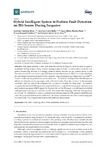Hybrid Intelligent System to Perform Fault Detection on BIS Sensor During Surgeries

Use este enlace para citar
http://hdl.handle.net/2183/19479Coleccións
- GI-CTC - Artigos [56]
Metadatos
Mostrar o rexistro completo do ítemTítulo
Hybrid Intelligent System to Perform Fault Detection on BIS Sensor During SurgeriesAutor(es)
Data
2017Cita bibliográfica
Casteleiro-Roca, J. L., Calvo-Rolle, J. L., Méndez Pérez, J. A., Roqueñí Gutiérrez, N., & de Cos Juez, F. J. (2017). Hybrid Intelligent System to Perform Fault Detection on BIS Sensor During Surgeries. Sensors, 17(1), 179.
Resumo
This paper presents a new fault detection system in hypnotic sensors used for general anesthesia during surgery. Drug infusion during surgery is based on information received from patient monitoring devices; accordingly, faults in sensor devices can put patient safety at risk. Our research offers a solution to cope with these undesirable scenarios. We focus on the anesthesia process using intravenous propofol as the hypnotic drug and employing a Bispectral Index (BISTM) monitor to estimate the patient’s unconsciousness level. The method developed identifies BIS episodes affected by disturbances during surgery with null clinical value. Thus, the clinician—or the automatic controller—will not take those measures into account to calculate the drug dose. Our method compares the measured BIS signal with expected behavior predicted by the propofol dose provider and the electromyogram (EMG) signal. For the prediction of the BIS signal, a model based on a hybrid intelligent system architecture has been created. The model uses clustering combined with regression techniques. To validate its accuracy, a dataset taken during surgeries with general anesthesia was used. The proposed fault detection method for BIS sensor measures has also been verified using data from real cases. The obtained results prove the method’s effectiveness.
Palabras chave
Emg
Bis
Clustering
Mlp
Svm
Anesthesia
Dosification
Bis
Clustering
Mlp
Svm
Anesthesia
Dosification
Versión do editor
Dereitos
Reconocimiento 3.0
ISSN
1424-8220






